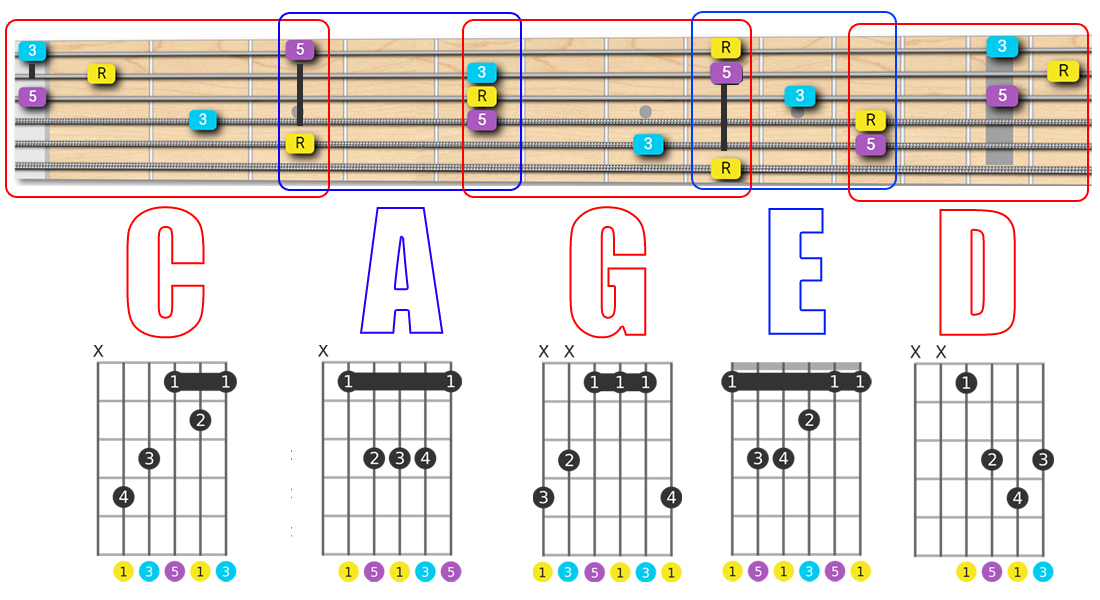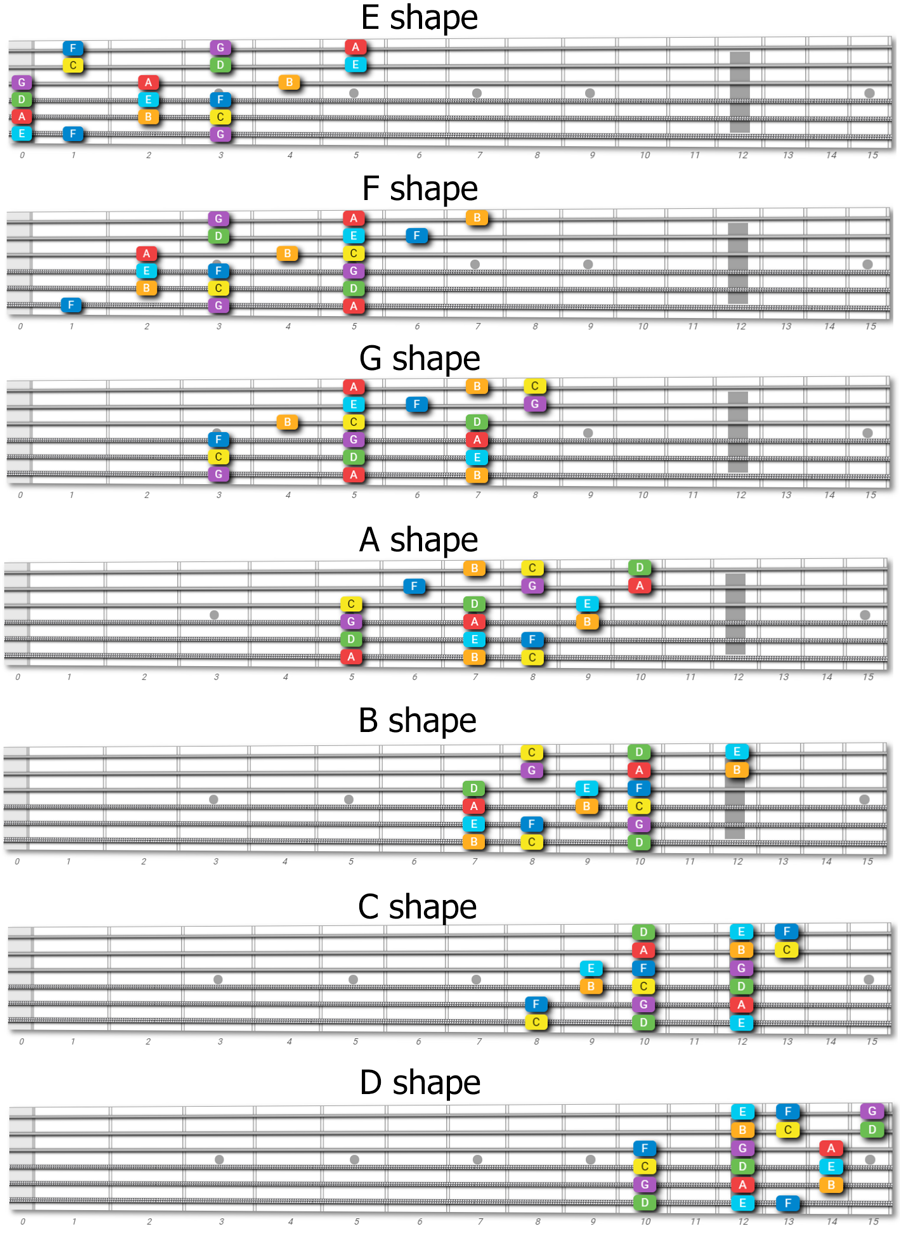3 Notes Per String Guitar Scales
Effective Exercise To Master 3 Nps Patterns
In the video below I'll show you a helpful exercise to internalize 3 notes per string scale patterns.
3 notes per string (3 nps) come in handy in many situations, as we will see in the following.
What Are 3 Notes Per String Scale Fingerings
Three notes per string (3NPS) scale fingering is a technique used to navigate scales across the fretboard, in which you play strictly 3 notes on each string:

3 nps pattern for the G Mixolydian Scale
The main advantages of 3 notes per string fingerings are:
- Speed and Efficiency: with three notes on each string, you can cover more ground on the fretboard without changing positions as frequently. This can facilitate faster playing, particularly in scalar passages and when performing patterns that span several octaves.
- Fluid String-to-String Transitions: Since there is no need to shift positions after playing three notes on a string, transitioning from one string to another becomes more fluid. This can contribute to smoother and more seamless playing, especially in fast-paced sections where rapid string changes are required.
- Symmetry and Patterns: The 3NPS system often creates symmetrical patterns on the fretboard, which can be visually appealing and facilitate memorization. This symmetry can be particularly useful when improvising or navigating complex modal scales or extended arpeggios.
However, 3 nps patterns can be difficult due to their bigger width.
Playing three notes on a single string can require a wider hand stretch compared to other fingering systems.
This can be challenging, especially for players with smaller hands or those who are not accustomed to stretching their fingers over long distances.
It may also lead to fatigue or discomfort during extended periods of playing.
Exercise Tips and Guitar Tabs
Here's below the guitar tabs of the exercise:

The exercise is built on the G Mixolydian scale, starting from the E low string.
As you can see on the notation, is composed of a series of triplets, a kind of music duration that matches really well with 3 nps fingerings.
Triplets
A triplet is a rhythmic device used to divide a beat into three equal parts. It is represented by a small "3" above or below a group of three notes or rests, indicating that they are to be played or held for the duration of one beat.
In a 3 nps scale context, this means that you cross strings exactly on each beat, with optimum logic and efficiency of motion.
In fact, you start with a down-stroke every time you change string (or the opposite, if you started with an upstroke).
How To Execute The Exercise
Start with a low BPM speed, 80 for example, and play a triplet (3 notes) on each beat.
You could also accent the first note, to better highlight the beat and string changes.
Be sure that every note rings clear, and if the required stretch is to wide for your range, shift the exercise 2 o 4 frets above (starting from note A or B instead of G)
CAGED vs 3 Notes Per String
Often 3 nps is seen has an alternative to the CAGED system.
In the CAGED system you have 5 reference shapes that help you navigate the fretboard:

In 3 NPS, you have 7 shapes which correspond to the seven notes of the Major Scale:

Which System Should I Learn?
My answer is...both!
Anyway, 3 nps is well suited for players that want to run fast up and down the fretboard, use shining techniques like alternate picking, legato and tapping (think Satriani, Vai, and other shredders).
CAGED gives you strong reference points to build and connect chords across all the fretboard.
If you learn well the two systems, you'll have a better understanding of the fretboard.
Further Ideas To Experiment With 3 Nps
3 Nps Pentatonic Scales
Try to apply the 3 nps concept to pentatonic scales.
It could really open up the neck, as, with this particular scale, the 3 nps shape will span the entire fretboard, allowing you to move horizontally:

E Minor Pentatonic Scale 3 Nps Guitar Pattern
You can find more patterns like this with my guitar scales finder tool and on the main guitar scale resource page.
Legato
The legato technique, which involves playing notes smoothly and connectedly without picking each note individually, can complement the 3 notes per string (3NPS) patterns on the guitar in several ways.
Legato playing reduces the reliance on picking every note, alleviating the strain on the picking hand.
With the 3NPS patterns, you can pick only the first note on each string and use your fretting hand to execute hammer-ons and pull-offs, giving the picking hand a break and conserving energy during extended passages or fast licks.
Also, you can maintain a constant flow of sound as you move across strings, resulting in smoother and more connected lines.
This is particularly advantageous for playing rapid scalar passages or executing melodic runs that require quick string changes.
This technique can be particularly advantageous in genres such as rock, fusion, or jazz where speed and technical proficiency are valued.
Conclusions and Resources To Download
This ends our brief introduction about 3 nps. Here's below you find the related resources of the exercise:
- 3 nps exercise guitar tabs Pdf file
- 3 nps exercise Guitar Pro tabs file
- My complete ebook Scales Over Chords | Learn How To Play The Right Scales Over Any Chord contains plenty of 3 nps fingering patterns as well as more scale knowledge.
To stay updated on new materials and exercises, leave your email here.